Business Communication: Unit 4 Report, Luton International College
VerifiedAdded on 2020/06/06
|18
|5033
|71
Report
AI Summary
This report, prepared by a student for the BTEC Level 3 Diploma in Business, Unit 4, comprehensively examines the multifaceted aspects of business communication. It begins by defining and analyzing different types of business information, including verbal, written, on-screen, multimedia, and web-based formats, detailing their origins and purposes, and analyzing their relevance in the context of a business. The report then delves into the evaluation of business information's appropriateness in strategic decision-making, using Tesco as a case study. It also covers the presentation of complex internal business information through written documents, verbal presentations, and PowerPoint, along with producing corporate communications for a chosen organization. Furthermore, it explores external corporate communications of an existing product or service, and evaluates the effectiveness of business information and its communication as key contributors to organizational success. The report concludes with a discussion of legal, ethical, and operational issues in relation to the use of business information, including security, backups, health and safety, organizational policies, and business continuance plans, providing a thorough overview of business communication principles and practices.
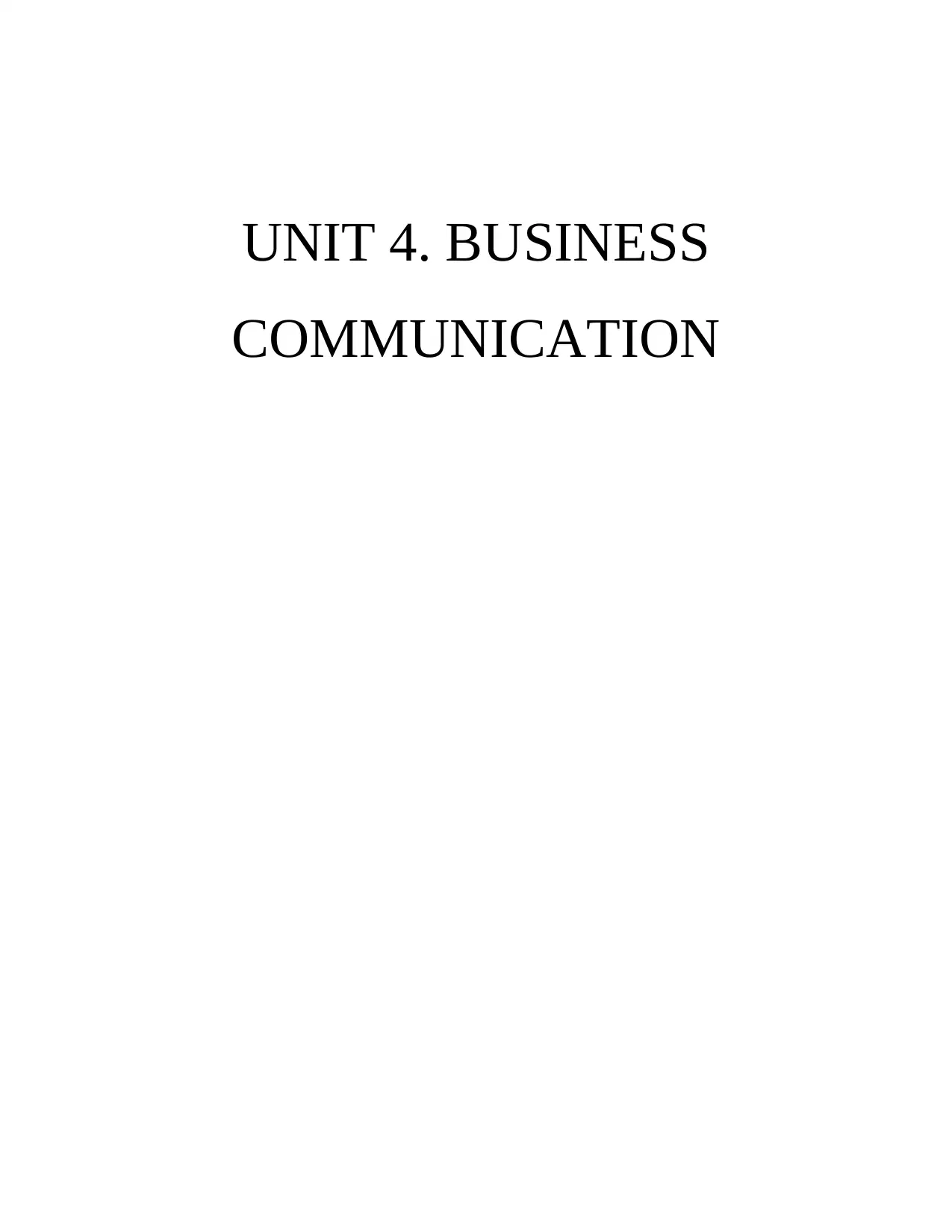
UNIT 4. BUSINESS
COMMUNICATION
COMMUNICATION
Paraphrase This Document
Need a fresh take? Get an instant paraphrase of this document with our AI Paraphraser
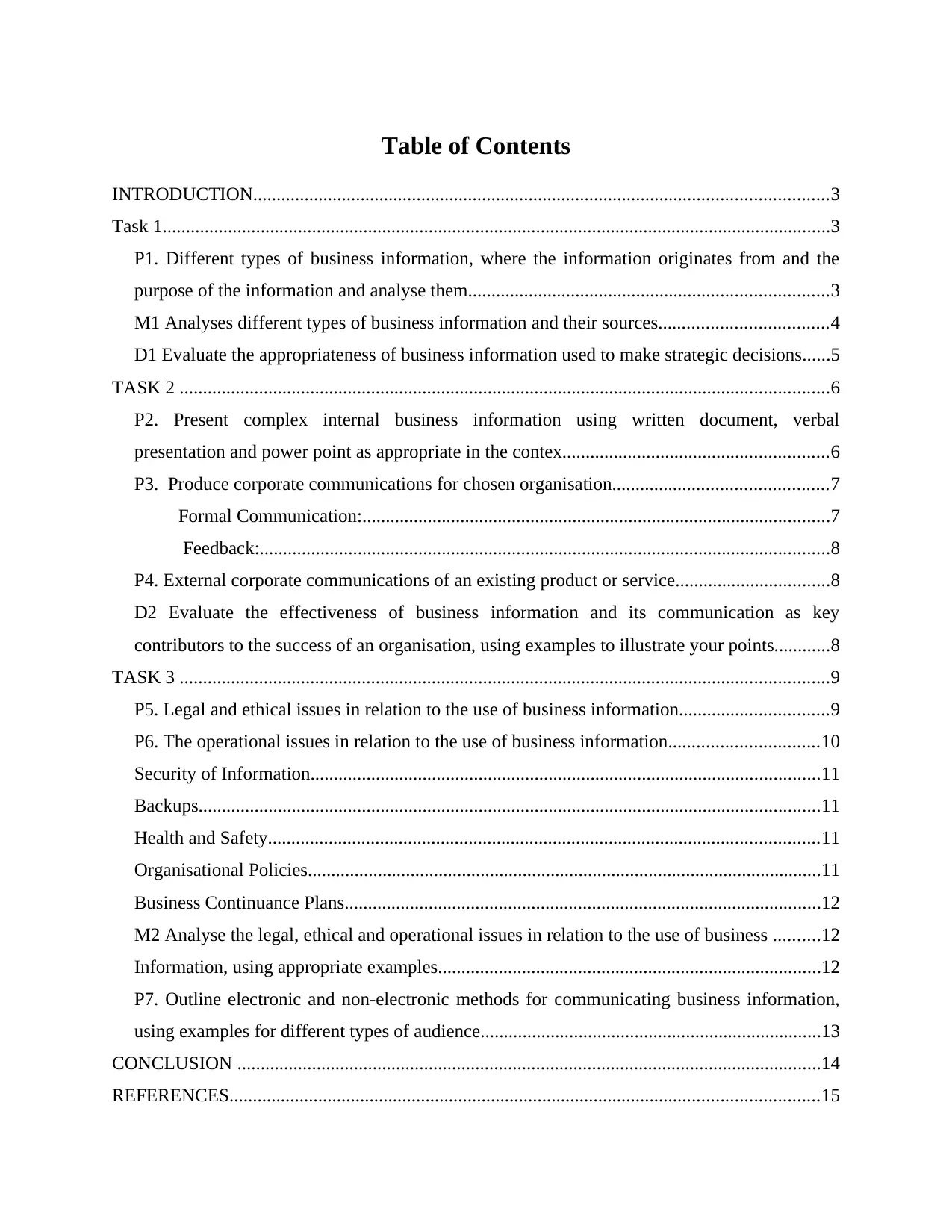
Table of Contents
INTRODUCTION...........................................................................................................................3
Task 1...............................................................................................................................................3
P1. Different types of business information, where the information originates from and the
purpose of the information and analyse them.............................................................................3
M1 Analyses different types of business information and their sources....................................4
D1 Evaluate the appropriateness of business information used to make strategic decisions......5
TASK 2 ...........................................................................................................................................6
P2. Present complex internal business information using written document, verbal
presentation and power point as appropriate in the contex.........................................................6
P3. Produce corporate communications for chosen organisation..............................................7
Formal Communication:....................................................................................................7
Feedback:..........................................................................................................................8
P4. External corporate communications of an existing product or service.................................8
D2 Evaluate the effectiveness of business information and its communication as key
contributors to the success of an organisation, using examples to illustrate your points............8
TASK 3 ...........................................................................................................................................9
P5. Legal and ethical issues in relation to the use of business information................................9
P6. The operational issues in relation to the use of business information................................10
Security of Information.............................................................................................................11
Backups.....................................................................................................................................11
Health and Safety......................................................................................................................11
Organisational Policies..............................................................................................................11
Business Continuance Plans......................................................................................................12
M2 Analyse the legal, ethical and operational issues in relation to the use of business ..........12
Information, using appropriate examples..................................................................................12
P7. Outline electronic and non-electronic methods for communicating business information,
using examples for different types of audience.........................................................................13
CONCLUSION .............................................................................................................................14
REFERENCES..............................................................................................................................15
INTRODUCTION...........................................................................................................................3
Task 1...............................................................................................................................................3
P1. Different types of business information, where the information originates from and the
purpose of the information and analyse them.............................................................................3
M1 Analyses different types of business information and their sources....................................4
D1 Evaluate the appropriateness of business information used to make strategic decisions......5
TASK 2 ...........................................................................................................................................6
P2. Present complex internal business information using written document, verbal
presentation and power point as appropriate in the contex.........................................................6
P3. Produce corporate communications for chosen organisation..............................................7
Formal Communication:....................................................................................................7
Feedback:..........................................................................................................................8
P4. External corporate communications of an existing product or service.................................8
D2 Evaluate the effectiveness of business information and its communication as key
contributors to the success of an organisation, using examples to illustrate your points............8
TASK 3 ...........................................................................................................................................9
P5. Legal and ethical issues in relation to the use of business information................................9
P6. The operational issues in relation to the use of business information................................10
Security of Information.............................................................................................................11
Backups.....................................................................................................................................11
Health and Safety......................................................................................................................11
Organisational Policies..............................................................................................................11
Business Continuance Plans......................................................................................................12
M2 Analyse the legal, ethical and operational issues in relation to the use of business ..........12
Information, using appropriate examples..................................................................................12
P7. Outline electronic and non-electronic methods for communicating business information,
using examples for different types of audience.........................................................................13
CONCLUSION .............................................................................................................................14
REFERENCES..............................................................................................................................15
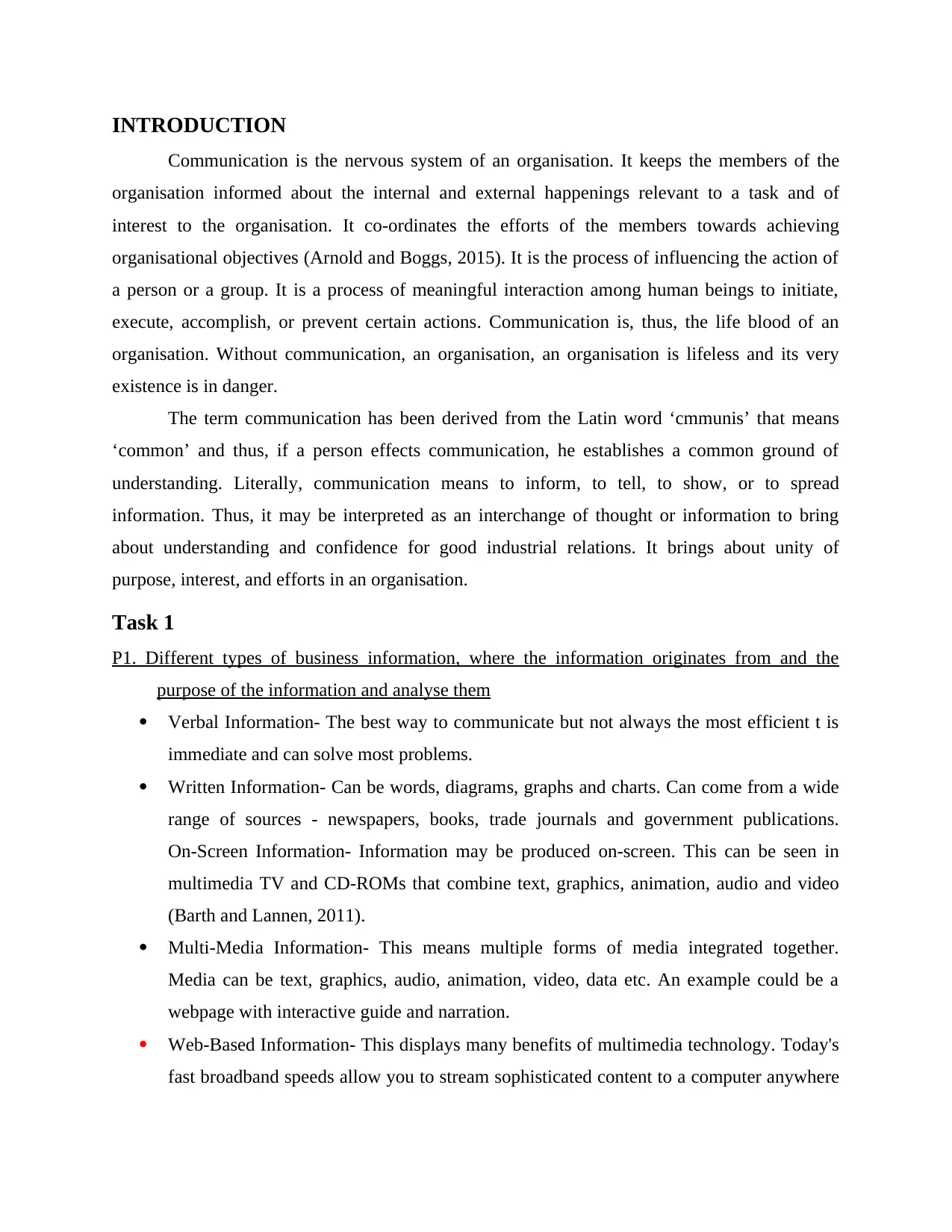
INTRODUCTION
Communication is the nervous system of an organisation. It keeps the members of the
organisation informed about the internal and external happenings relevant to a task and of
interest to the organisation. It co-ordinates the efforts of the members towards achieving
organisational objectives (Arnold and Boggs, 2015). It is the process of influencing the action of
a person or a group. It is a process of meaningful interaction among human beings to initiate,
execute, accomplish, or prevent certain actions. Communication is, thus, the life blood of an
organisation. Without communication, an organisation, an organisation is lifeless and its very
existence is in danger.
The term communication has been derived from the Latin word ‘cmmunis’ that means
‘common’ and thus, if a person effects communication, he establishes a common ground of
understanding. Literally, communication means to inform, to tell, to show, or to spread
information. Thus, it may be interpreted as an interchange of thought or information to bring
about understanding and confidence for good industrial relations. It brings about unity of
purpose, interest, and efforts in an organisation.
Task 1
P1. Different types of business information, where the information originates from and the
purpose of the information and analyse them
Verbal Information- The best way to communicate but not always the most efficient t is
immediate and can solve most problems.
Written Information- Can be words, diagrams, graphs and charts. Can come from a wide
range of sources - newspapers, books, trade journals and government publications.
On-Screen Information- Information may be produced on-screen. This can be seen in
multimedia TV and CD-ROMs that combine text, graphics, animation, audio and video
(Barth and Lannen, 2011).
Multi-Media Information- This means multiple forms of media integrated together.
Media can be text, graphics, audio, animation, video, data etc. An example could be a
webpage with interactive guide and narration.
Web-Based Information- This displays many benefits of multimedia technology. Today's
fast broadband speeds allow you to stream sophisticated content to a computer anywhere
Communication is the nervous system of an organisation. It keeps the members of the
organisation informed about the internal and external happenings relevant to a task and of
interest to the organisation. It co-ordinates the efforts of the members towards achieving
organisational objectives (Arnold and Boggs, 2015). It is the process of influencing the action of
a person or a group. It is a process of meaningful interaction among human beings to initiate,
execute, accomplish, or prevent certain actions. Communication is, thus, the life blood of an
organisation. Without communication, an organisation, an organisation is lifeless and its very
existence is in danger.
The term communication has been derived from the Latin word ‘cmmunis’ that means
‘common’ and thus, if a person effects communication, he establishes a common ground of
understanding. Literally, communication means to inform, to tell, to show, or to spread
information. Thus, it may be interpreted as an interchange of thought or information to bring
about understanding and confidence for good industrial relations. It brings about unity of
purpose, interest, and efforts in an organisation.
Task 1
P1. Different types of business information, where the information originates from and the
purpose of the information and analyse them
Verbal Information- The best way to communicate but not always the most efficient t is
immediate and can solve most problems.
Written Information- Can be words, diagrams, graphs and charts. Can come from a wide
range of sources - newspapers, books, trade journals and government publications.
On-Screen Information- Information may be produced on-screen. This can be seen in
multimedia TV and CD-ROMs that combine text, graphics, animation, audio and video
(Barth and Lannen, 2011).
Multi-Media Information- This means multiple forms of media integrated together.
Media can be text, graphics, audio, animation, video, data etc. An example could be a
webpage with interactive guide and narration.
Web-Based Information- This displays many benefits of multimedia technology. Today's
fast broadband speeds allow you to stream sophisticated content to a computer anywhere
⊘ This is a preview!⊘
Do you want full access?
Subscribe today to unlock all pages.

Trusted by 1+ million students worldwide
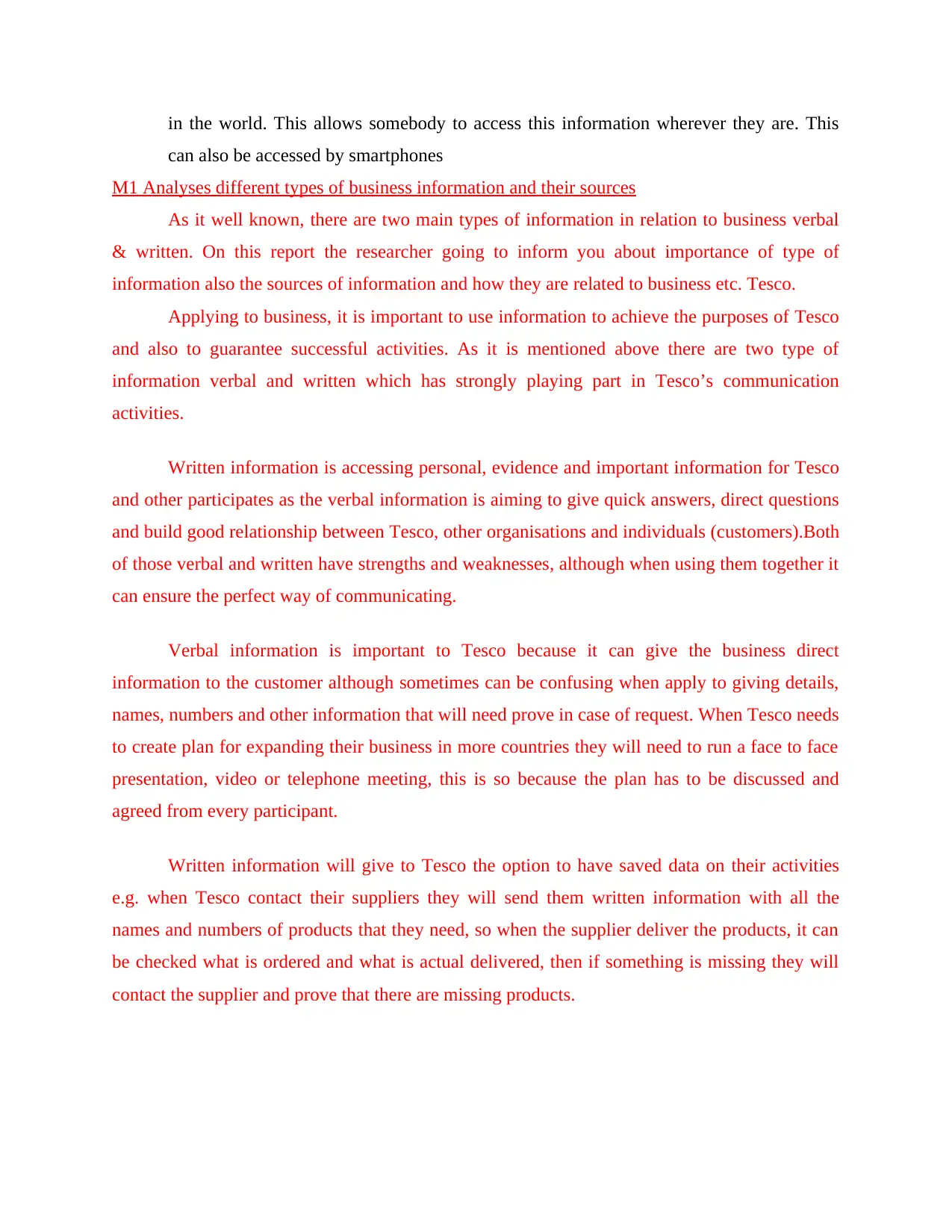
in the world. This allows somebody to access this information wherever they are. This
can also be accessed by smartphones
M1 Analyses different types of business information and their sources
As it well known, there are two main types of information in relation to business verbal
& written. On this report the researcher going to inform you about importance of type of
information also the sources of information and how they are related to business etc. Tesco.
Applying to business, it is important to use information to achieve the purposes of Tesco
and also to guarantee successful activities. As it is mentioned above there are two type of
information verbal and written which has strongly playing part in Tesco’s communication
activities.
Written information is accessing personal, evidence and important information for Tesco
and other participates as the verbal information is aiming to give quick answers, direct questions
and build good relationship between Tesco, other organisations and individuals (customers).Both
of those verbal and written have strengths and weaknesses, although when using them together it
can ensure the perfect way of communicating.
Verbal information is important to Tesco because it can give the business direct
information to the customer although sometimes can be confusing when apply to giving details,
names, numbers and other information that will need prove in case of request. When Tesco needs
to create plan for expanding their business in more countries they will need to run a face to face
presentation, video or telephone meeting, this is so because the plan has to be discussed and
agreed from every participant.
Written information will give to Tesco the option to have saved data on their activities
e.g. when Tesco contact their suppliers they will send them written information with all the
names and numbers of products that they need, so when the supplier deliver the products, it can
be checked what is ordered and what is actual delivered, then if something is missing they will
contact the supplier and prove that there are missing products.
can also be accessed by smartphones
M1 Analyses different types of business information and their sources
As it well known, there are two main types of information in relation to business verbal
& written. On this report the researcher going to inform you about importance of type of
information also the sources of information and how they are related to business etc. Tesco.
Applying to business, it is important to use information to achieve the purposes of Tesco
and also to guarantee successful activities. As it is mentioned above there are two type of
information verbal and written which has strongly playing part in Tesco’s communication
activities.
Written information is accessing personal, evidence and important information for Tesco
and other participates as the verbal information is aiming to give quick answers, direct questions
and build good relationship between Tesco, other organisations and individuals (customers).Both
of those verbal and written have strengths and weaknesses, although when using them together it
can ensure the perfect way of communicating.
Verbal information is important to Tesco because it can give the business direct
information to the customer although sometimes can be confusing when apply to giving details,
names, numbers and other information that will need prove in case of request. When Tesco needs
to create plan for expanding their business in more countries they will need to run a face to face
presentation, video or telephone meeting, this is so because the plan has to be discussed and
agreed from every participant.
Written information will give to Tesco the option to have saved data on their activities
e.g. when Tesco contact their suppliers they will send them written information with all the
names and numbers of products that they need, so when the supplier deliver the products, it can
be checked what is ordered and what is actual delivered, then if something is missing they will
contact the supplier and prove that there are missing products.
Paraphrase This Document
Need a fresh take? Get an instant paraphrase of this document with our AI Paraphraser
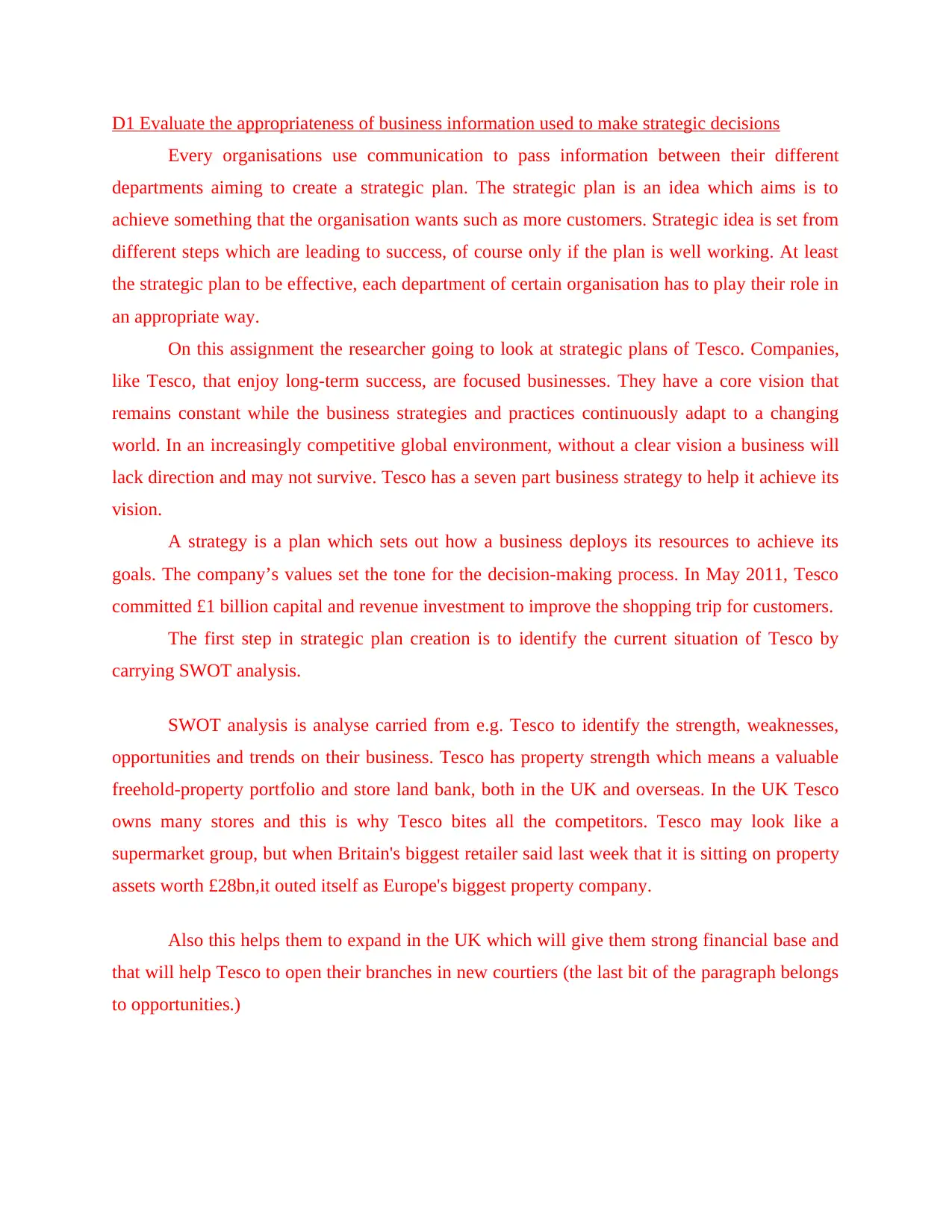
D1 Evaluate the appropriateness of business information used to make strategic decisions
Every organisations use communication to pass information between their different
departments aiming to create a strategic plan. The strategic plan is an idea which aims is to
achieve something that the organisation wants such as more customers. Strategic idea is set from
different steps which are leading to success, of course only if the plan is well working. At least
the strategic plan to be effective, each department of certain organisation has to play their role in
an appropriate way.
On this assignment the researcher going to look at strategic plans of Tesco. Companies,
like Tesco, that enjoy long-term success, are focused businesses. They have a core vision that
remains constant while the business strategies and practices continuously adapt to a changing
world. In an increasingly competitive global environment, without a clear vision a business will
lack direction and may not survive. Tesco has a seven part business strategy to help it achieve its
vision.
A strategy is a plan which sets out how a business deploys its resources to achieve its
goals. The company’s values set the tone for the decision-making process. In May 2011, Tesco
committed £1 billion capital and revenue investment to improve the shopping trip for customers.
The first step in strategic plan creation is to identify the current situation of Tesco by
carrying SWOT analysis.
SWOT analysis is analyse carried from e.g. Tesco to identify the strength, weaknesses,
opportunities and trends on their business. Tesco has property strength which means a valuable
freehold-property portfolio and store land bank, both in the UK and overseas. In the UK Tesco
owns many stores and this is why Tesco bites all the competitors. Tesco may look like a
supermarket group, but when Britain's biggest retailer said last week that it is sitting on property
assets worth £28bn,it outed itself as Europe's biggest property company.
Also this helps them to expand in the UK which will give them strong financial base and
that will help Tesco to open their branches in new courtiers (the last bit of the paragraph belongs
to opportunities.)
Every organisations use communication to pass information between their different
departments aiming to create a strategic plan. The strategic plan is an idea which aims is to
achieve something that the organisation wants such as more customers. Strategic idea is set from
different steps which are leading to success, of course only if the plan is well working. At least
the strategic plan to be effective, each department of certain organisation has to play their role in
an appropriate way.
On this assignment the researcher going to look at strategic plans of Tesco. Companies,
like Tesco, that enjoy long-term success, are focused businesses. They have a core vision that
remains constant while the business strategies and practices continuously adapt to a changing
world. In an increasingly competitive global environment, without a clear vision a business will
lack direction and may not survive. Tesco has a seven part business strategy to help it achieve its
vision.
A strategy is a plan which sets out how a business deploys its resources to achieve its
goals. The company’s values set the tone for the decision-making process. In May 2011, Tesco
committed £1 billion capital and revenue investment to improve the shopping trip for customers.
The first step in strategic plan creation is to identify the current situation of Tesco by
carrying SWOT analysis.
SWOT analysis is analyse carried from e.g. Tesco to identify the strength, weaknesses,
opportunities and trends on their business. Tesco has property strength which means a valuable
freehold-property portfolio and store land bank, both in the UK and overseas. In the UK Tesco
owns many stores and this is why Tesco bites all the competitors. Tesco may look like a
supermarket group, but when Britain's biggest retailer said last week that it is sitting on property
assets worth £28bn,it outed itself as Europe's biggest property company.
Also this helps them to expand in the UK which will give them strong financial base and
that will help Tesco to open their branches in new courtiers (the last bit of the paragraph belongs
to opportunities.)
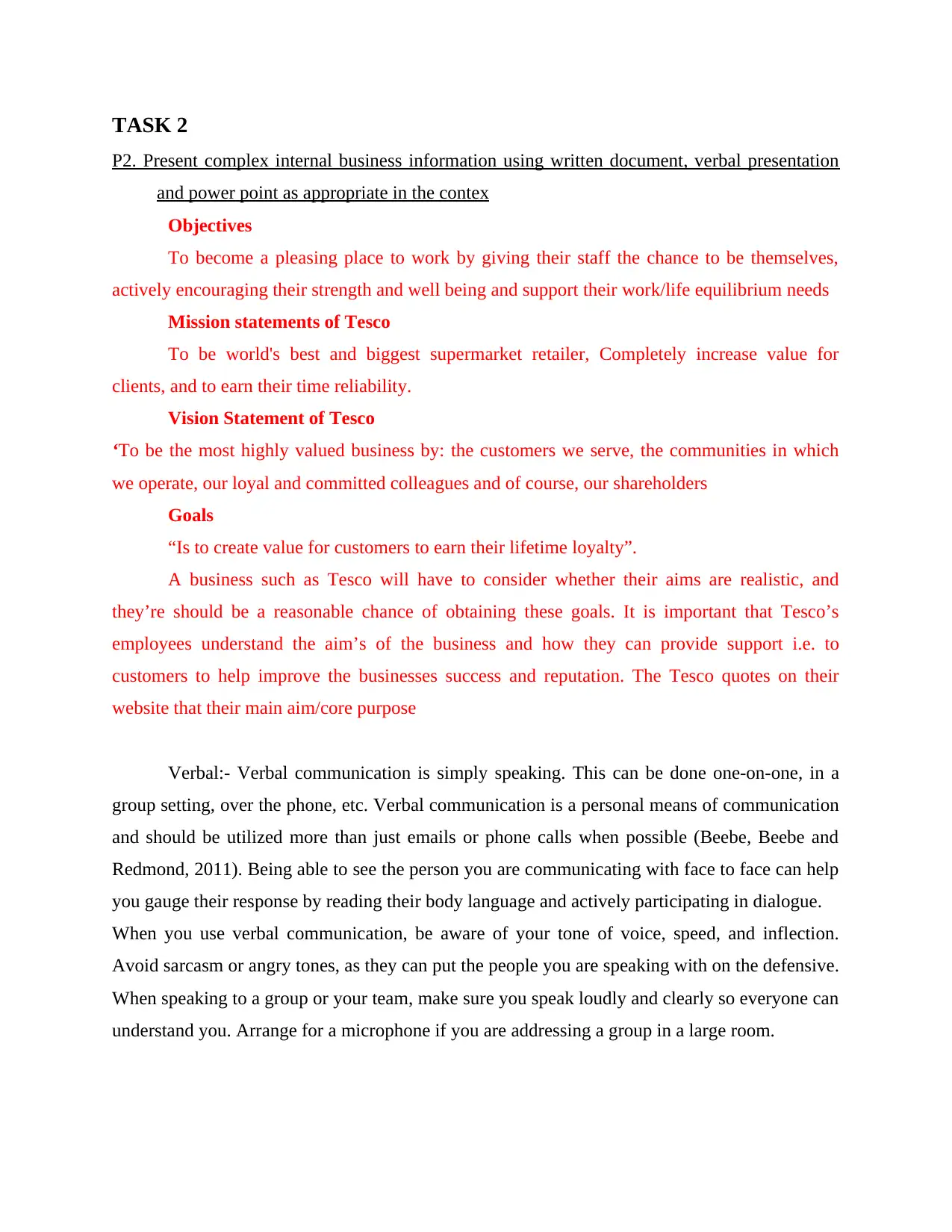
TASK 2
P2. Present complex internal business information using written document, verbal presentation
and power point as appropriate in the contex
Objectives
To become a pleasing place to work by giving their staff the chance to be themselves,
actively encouraging their strength and well being and support their work/life equilibrium needs
Mission statements of Tesco
To be world's best and biggest supermarket retailer, Completely increase value for
clients, and to earn their time reliability.
Vision Statement of Tesco
‘To be the most highly valued business by: the customers we serve, the communities in which
we operate, our loyal and committed colleagues and of course, our shareholders
Goals
“Is to create value for customers to earn their lifetime loyalty”.
A business such as Tesco will have to consider whether their aims are realistic, and
they’re should be a reasonable chance of obtaining these goals. It is important that Tesco’s
employees understand the aim’s of the business and how they can provide support i.e. to
customers to help improve the businesses success and reputation. The Tesco quotes on their
website that their main aim/core purpose
Verbal:- Verbal communication is simply speaking. This can be done one-on-one, in a
group setting, over the phone, etc. Verbal communication is a personal means of communication
and should be utilized more than just emails or phone calls when possible (Beebe, Beebe and
Redmond, 2011). Being able to see the person you are communicating with face to face can help
you gauge their response by reading their body language and actively participating in dialogue.
When you use verbal communication, be aware of your tone of voice, speed, and inflection.
Avoid sarcasm or angry tones, as they can put the people you are speaking with on the defensive.
When speaking to a group or your team, make sure you speak loudly and clearly so everyone can
understand you. Arrange for a microphone if you are addressing a group in a large room.
P2. Present complex internal business information using written document, verbal presentation
and power point as appropriate in the contex
Objectives
To become a pleasing place to work by giving their staff the chance to be themselves,
actively encouraging their strength and well being and support their work/life equilibrium needs
Mission statements of Tesco
To be world's best and biggest supermarket retailer, Completely increase value for
clients, and to earn their time reliability.
Vision Statement of Tesco
‘To be the most highly valued business by: the customers we serve, the communities in which
we operate, our loyal and committed colleagues and of course, our shareholders
Goals
“Is to create value for customers to earn their lifetime loyalty”.
A business such as Tesco will have to consider whether their aims are realistic, and
they’re should be a reasonable chance of obtaining these goals. It is important that Tesco’s
employees understand the aim’s of the business and how they can provide support i.e. to
customers to help improve the businesses success and reputation. The Tesco quotes on their
website that their main aim/core purpose
Verbal:- Verbal communication is simply speaking. This can be done one-on-one, in a
group setting, over the phone, etc. Verbal communication is a personal means of communication
and should be utilized more than just emails or phone calls when possible (Beebe, Beebe and
Redmond, 2011). Being able to see the person you are communicating with face to face can help
you gauge their response by reading their body language and actively participating in dialogue.
When you use verbal communication, be aware of your tone of voice, speed, and inflection.
Avoid sarcasm or angry tones, as they can put the people you are speaking with on the defensive.
When speaking to a group or your team, make sure you speak loudly and clearly so everyone can
understand you. Arrange for a microphone if you are addressing a group in a large room.
⊘ This is a preview!⊘
Do you want full access?
Subscribe today to unlock all pages.

Trusted by 1+ million students worldwide
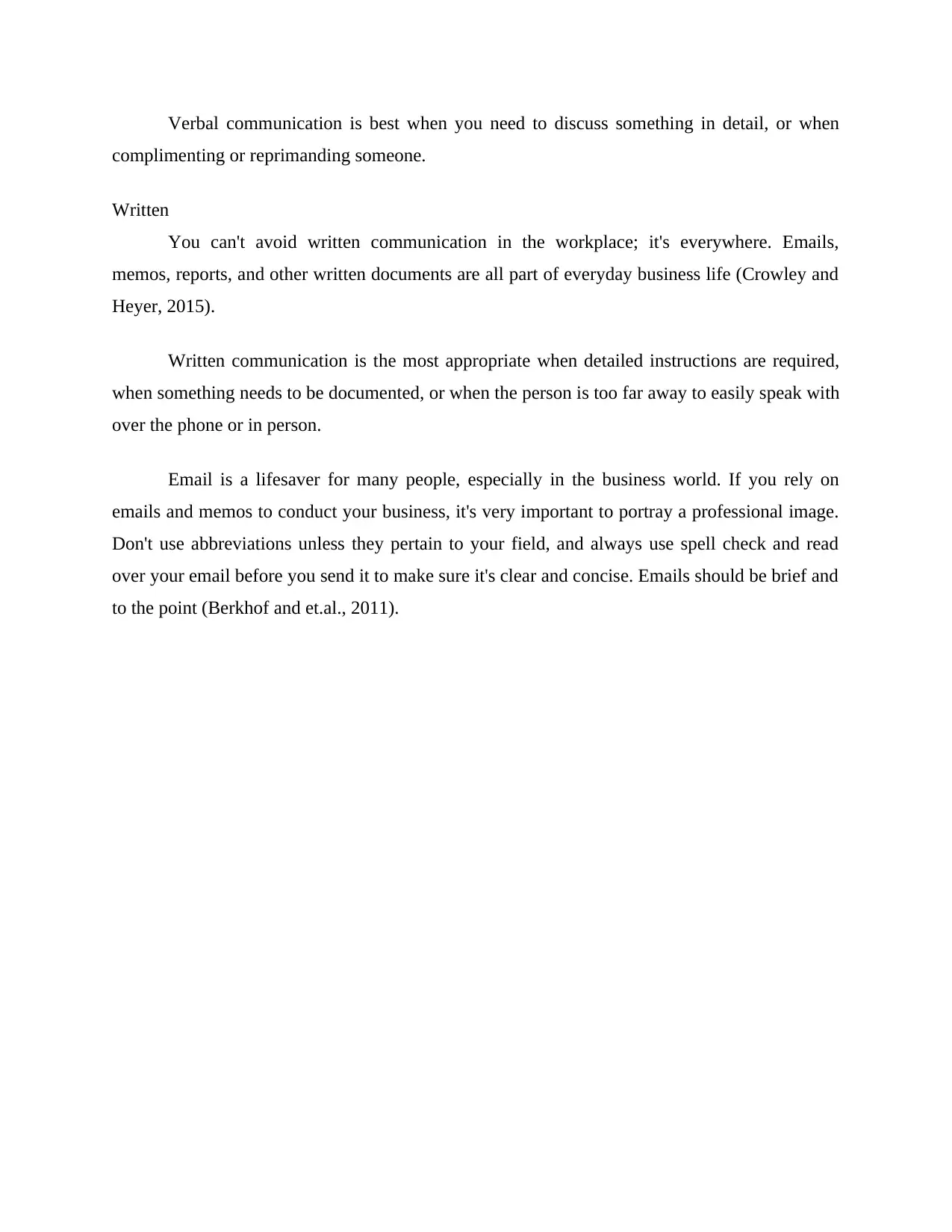
Verbal communication is best when you need to discuss something in detail, or when
complimenting or reprimanding someone.
Written
You can't avoid written communication in the workplace; it's everywhere. Emails,
memos, reports, and other written documents are all part of everyday business life (Crowley and
Heyer, 2015).
Written communication is the most appropriate when detailed instructions are required,
when something needs to be documented, or when the person is too far away to easily speak with
over the phone or in person.
Email is a lifesaver for many people, especially in the business world. If you rely on
emails and memos to conduct your business, it's very important to portray a professional image.
Don't use abbreviations unless they pertain to your field, and always use spell check and read
over your email before you send it to make sure it's clear and concise. Emails should be brief and
to the point (Berkhof and et.al., 2011).
complimenting or reprimanding someone.
Written
You can't avoid written communication in the workplace; it's everywhere. Emails,
memos, reports, and other written documents are all part of everyday business life (Crowley and
Heyer, 2015).
Written communication is the most appropriate when detailed instructions are required,
when something needs to be documented, or when the person is too far away to easily speak with
over the phone or in person.
Email is a lifesaver for many people, especially in the business world. If you rely on
emails and memos to conduct your business, it's very important to portray a professional image.
Don't use abbreviations unless they pertain to your field, and always use spell check and read
over your email before you send it to make sure it's clear and concise. Emails should be brief and
to the point (Berkhof and et.al., 2011).
Paraphrase This Document
Need a fresh take? Get an instant paraphrase of this document with our AI Paraphraser

P3 covered in posters
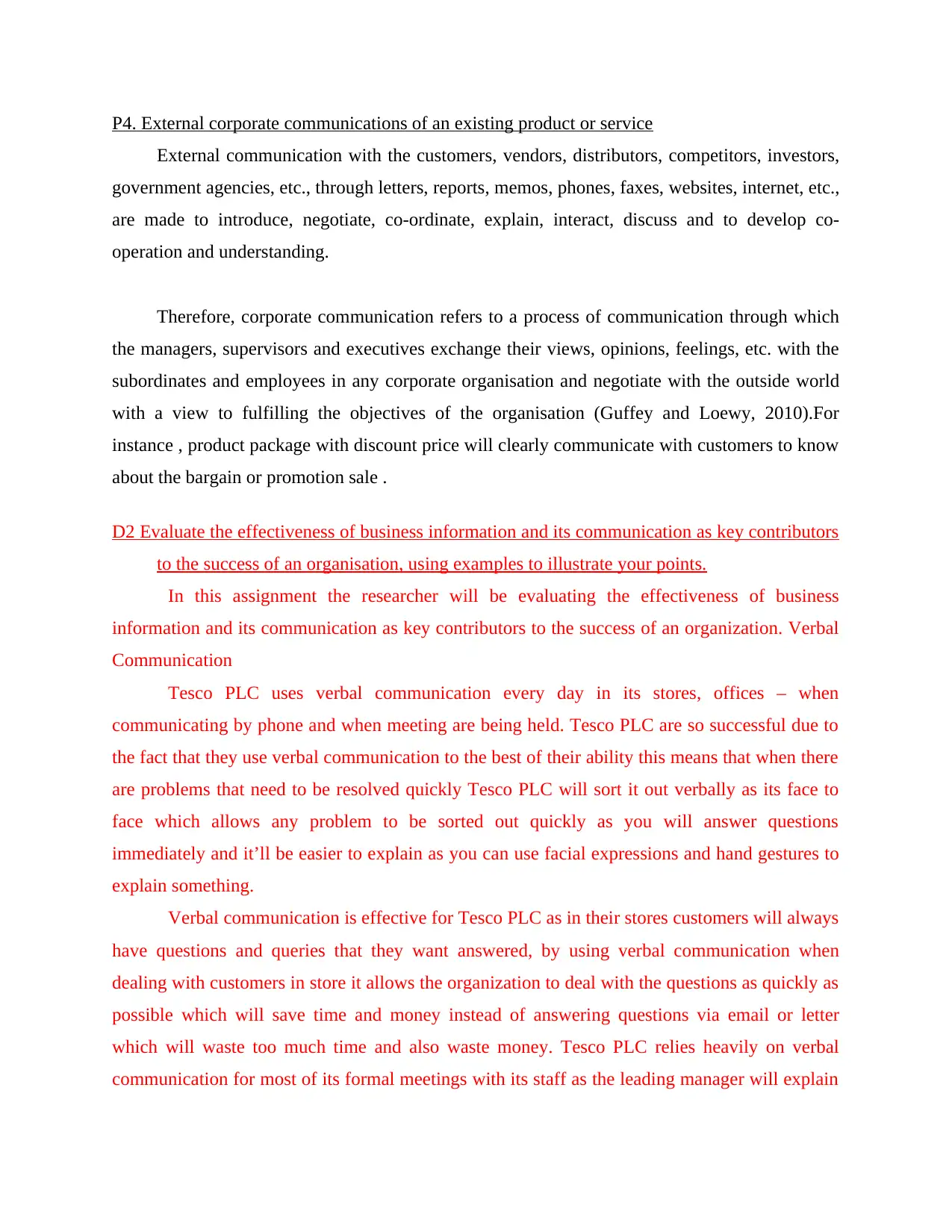
P4. External corporate communications of an existing product or service
External communication with the customers, vendors, distributors, competitors, investors,
government agencies, etc., through letters, reports, memos, phones, faxes, websites, internet, etc.,
are made to introduce, negotiate, co-ordinate, explain, interact, discuss and to develop co-
operation and understanding.
Therefore, corporate communication refers to a process of communication through which
the managers, supervisors and executives exchange their views, opinions, feelings, etc. with the
subordinates and employees in any corporate organisation and negotiate with the outside world
with a view to fulfilling the objectives of the organisation (Guffey and Loewy, 2010).For
instance , product package with discount price will clearly communicate with customers to know
about the bargain or promotion sale .
D2 Evaluate the effectiveness of business information and its communication as key contributors
to the success of an organisation, using examples to illustrate your points.
In this assignment the researcher will be evaluating the effectiveness of business
information and its communication as key contributors to the success of an organization. Verbal
Communication
Tesco PLC uses verbal communication every day in its stores, offices – when
communicating by phone and when meeting are being held. Tesco PLC are so successful due to
the fact that they use verbal communication to the best of their ability this means that when there
are problems that need to be resolved quickly Tesco PLC will sort it out verbally as its face to
face which allows any problem to be sorted out quickly as you will answer questions
immediately and it’ll be easier to explain as you can use facial expressions and hand gestures to
explain something.
Verbal communication is effective for Tesco PLC as in their stores customers will always
have questions and queries that they want answered, by using verbal communication when
dealing with customers in store it allows the organization to deal with the questions as quickly as
possible which will save time and money instead of answering questions via email or letter
which will waste too much time and also waste money. Tesco PLC relies heavily on verbal
communication for most of its formal meetings with its staff as the leading manager will explain
External communication with the customers, vendors, distributors, competitors, investors,
government agencies, etc., through letters, reports, memos, phones, faxes, websites, internet, etc.,
are made to introduce, negotiate, co-ordinate, explain, interact, discuss and to develop co-
operation and understanding.
Therefore, corporate communication refers to a process of communication through which
the managers, supervisors and executives exchange their views, opinions, feelings, etc. with the
subordinates and employees in any corporate organisation and negotiate with the outside world
with a view to fulfilling the objectives of the organisation (Guffey and Loewy, 2010).For
instance , product package with discount price will clearly communicate with customers to know
about the bargain or promotion sale .
D2 Evaluate the effectiveness of business information and its communication as key contributors
to the success of an organisation, using examples to illustrate your points.
In this assignment the researcher will be evaluating the effectiveness of business
information and its communication as key contributors to the success of an organization. Verbal
Communication
Tesco PLC uses verbal communication every day in its stores, offices – when
communicating by phone and when meeting are being held. Tesco PLC are so successful due to
the fact that they use verbal communication to the best of their ability this means that when there
are problems that need to be resolved quickly Tesco PLC will sort it out verbally as its face to
face which allows any problem to be sorted out quickly as you will answer questions
immediately and it’ll be easier to explain as you can use facial expressions and hand gestures to
explain something.
Verbal communication is effective for Tesco PLC as in their stores customers will always
have questions and queries that they want answered, by using verbal communication when
dealing with customers in store it allows the organization to deal with the questions as quickly as
possible which will save time and money instead of answering questions via email or letter
which will waste too much time and also waste money. Tesco PLC relies heavily on verbal
communication for most of its formal meetings with its staff as the leading manager will explain
⊘ This is a preview!⊘
Do you want full access?
Subscribe today to unlock all pages.

Trusted by 1+ million students worldwide
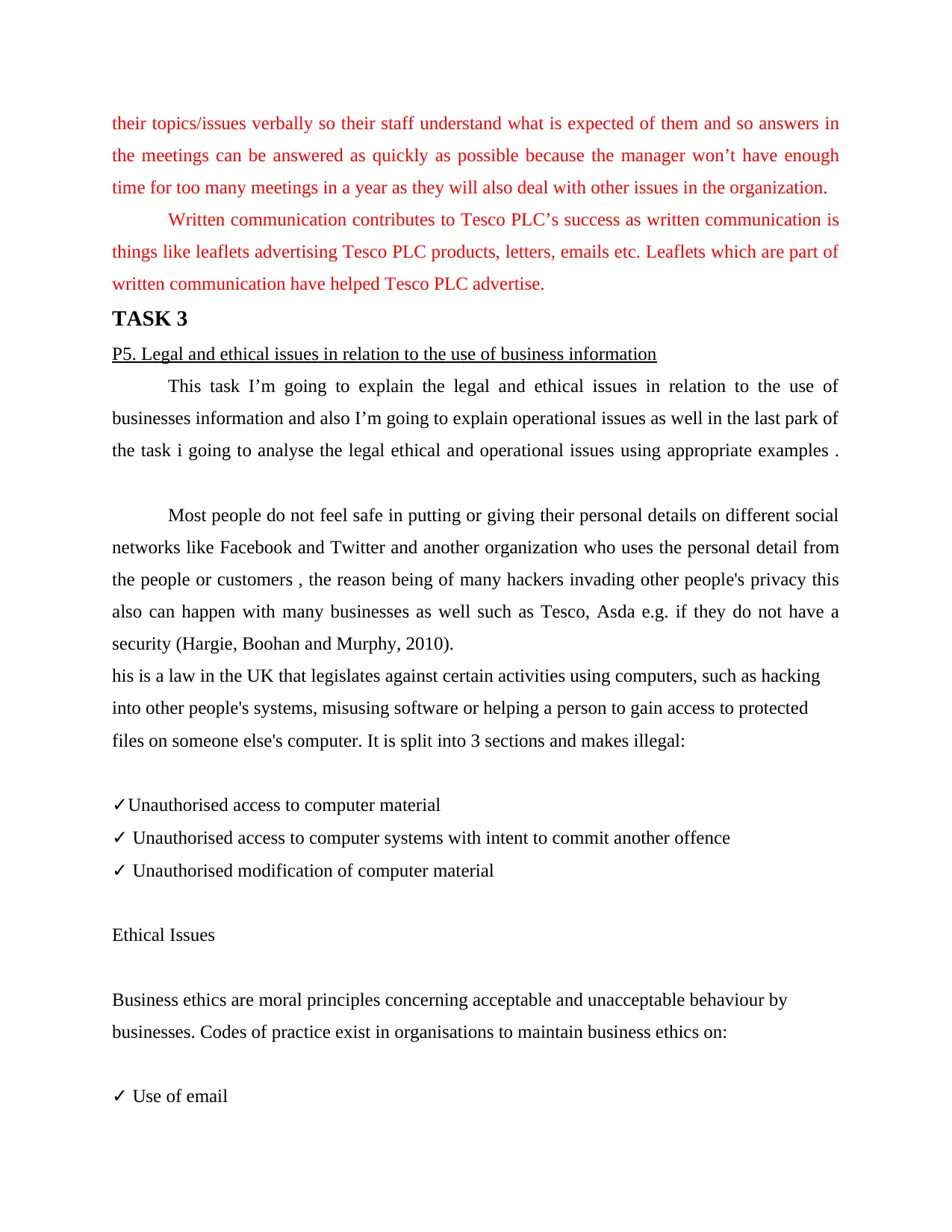
their topics/issues verbally so their staff understand what is expected of them and so answers in
the meetings can be answered as quickly as possible because the manager won’t have enough
time for too many meetings in a year as they will also deal with other issues in the organization.
Written communication contributes to Tesco PLC’s success as written communication is
things like leaflets advertising Tesco PLC products, letters, emails etc. Leaflets which are part of
written communication have helped Tesco PLC advertise.
TASK 3
P5. Legal and ethical issues in relation to the use of business information
This task I’m going to explain the legal and ethical issues in relation to the use of
businesses information and also I’m going to explain operational issues as well in the last park of
the task i going to analyse the legal ethical and operational issues using appropriate examples .
Most people do not feel safe in putting or giving their personal details on different social
networks like Facebook and Twitter and another organization who uses the personal detail from
the people or customers , the reason being of many hackers invading other people's privacy this
also can happen with many businesses as well such as Tesco, Asda e.g. if they do not have a
security (Hargie, Boohan and Murphy, 2010).
his is a law in the UK that legislates against certain activities using computers, such as hacking
into other people's systems, misusing software or helping a person to gain access to protected
files on someone else's computer. It is split into 3 sections and makes illegal:
✓Unauthorised access to computer material
✓ Unauthorised access to computer systems with intent to commit another offence
✓ Unauthorised modification of computer material
Ethical Issues
Business ethics are moral principles concerning acceptable and unacceptable behaviour by
businesses. Codes of practice exist in organisations to maintain business ethics on:
✓ Use of email
the meetings can be answered as quickly as possible because the manager won’t have enough
time for too many meetings in a year as they will also deal with other issues in the organization.
Written communication contributes to Tesco PLC’s success as written communication is
things like leaflets advertising Tesco PLC products, letters, emails etc. Leaflets which are part of
written communication have helped Tesco PLC advertise.
TASK 3
P5. Legal and ethical issues in relation to the use of business information
This task I’m going to explain the legal and ethical issues in relation to the use of
businesses information and also I’m going to explain operational issues as well in the last park of
the task i going to analyse the legal ethical and operational issues using appropriate examples .
Most people do not feel safe in putting or giving their personal details on different social
networks like Facebook and Twitter and another organization who uses the personal detail from
the people or customers , the reason being of many hackers invading other people's privacy this
also can happen with many businesses as well such as Tesco, Asda e.g. if they do not have a
security (Hargie, Boohan and Murphy, 2010).
his is a law in the UK that legislates against certain activities using computers, such as hacking
into other people's systems, misusing software or helping a person to gain access to protected
files on someone else's computer. It is split into 3 sections and makes illegal:
✓Unauthorised access to computer material
✓ Unauthorised access to computer systems with intent to commit another offence
✓ Unauthorised modification of computer material
Ethical Issues
Business ethics are moral principles concerning acceptable and unacceptable behaviour by
businesses. Codes of practice exist in organisations to maintain business ethics on:
✓ Use of email
Paraphrase This Document
Need a fresh take? Get an instant paraphrase of this document with our AI Paraphraser
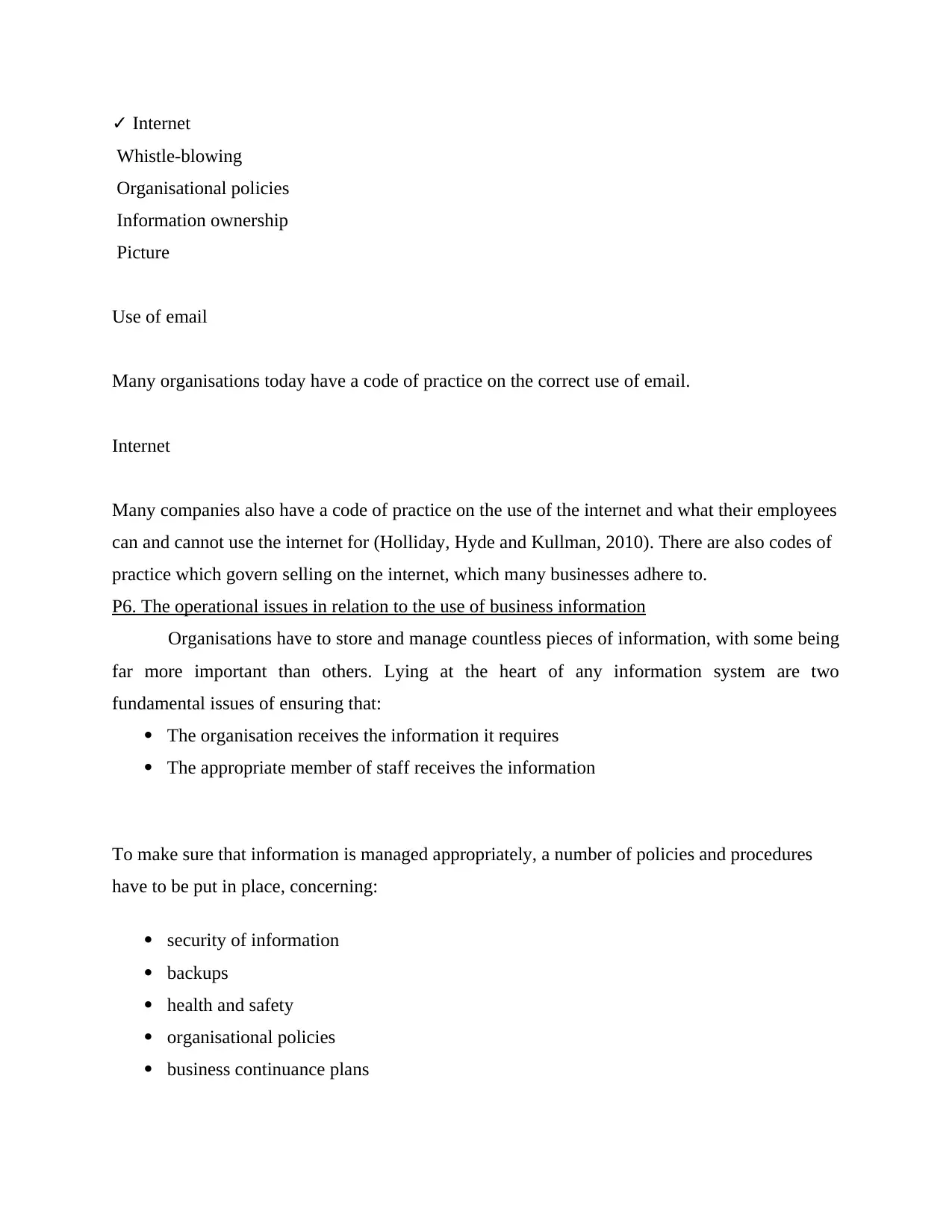
✓ Internet
Whistle-blowing
Organisational policies
Information ownership
Picture
Use of email
Many organisations today have a code of practice on the correct use of email.
Internet
Many companies also have a code of practice on the use of the internet and what their employees
can and cannot use the internet for (Holliday, Hyde and Kullman, 2010). There are also codes of
practice which govern selling on the internet, which many businesses adhere to.
P6. The operational issues in relation to the use of business information
Organisations have to store and manage countless pieces of information, with some being
far more important than others. Lying at the heart of any information system are two
fundamental issues of ensuring that:
The organisation receives the information it requires
The appropriate member of staff receives the information
To make sure that information is managed appropriately, a number of policies and procedures
have to be put in place, concerning:
security of information
backups
health and safety
organisational policies
business continuance plans
Whistle-blowing
Organisational policies
Information ownership
Picture
Use of email
Many organisations today have a code of practice on the correct use of email.
Internet
Many companies also have a code of practice on the use of the internet and what their employees
can and cannot use the internet for (Holliday, Hyde and Kullman, 2010). There are also codes of
practice which govern selling on the internet, which many businesses adhere to.
P6. The operational issues in relation to the use of business information
Organisations have to store and manage countless pieces of information, with some being
far more important than others. Lying at the heart of any information system are two
fundamental issues of ensuring that:
The organisation receives the information it requires
The appropriate member of staff receives the information
To make sure that information is managed appropriately, a number of policies and procedures
have to be put in place, concerning:
security of information
backups
health and safety
organisational policies
business continuance plans
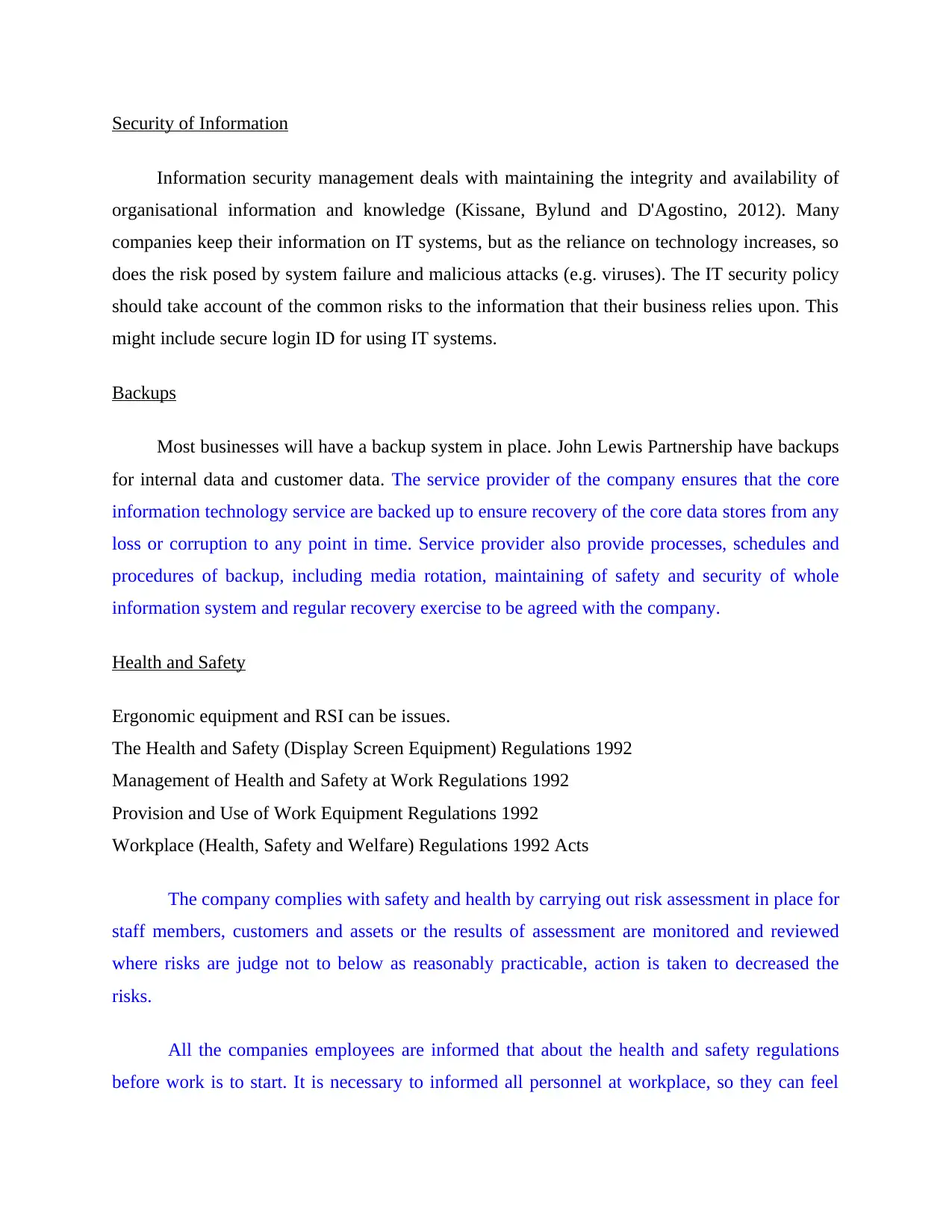
Security of Information
Information security management deals with maintaining the integrity and availability of
organisational information and knowledge (Kissane, Bylund and D'Agostino, 2012). Many
companies keep their information on IT systems, but as the reliance on technology increases, so
does the risk posed by system failure and malicious attacks (e.g. viruses). The IT security policy
should take account of the common risks to the information that their business relies upon. This
might include secure login ID for using IT systems.
Backups
Most businesses will have a backup system in place. John Lewis Partnership have backups
for internal data and customer data. The service provider of the company ensures that the core
information technology service are backed up to ensure recovery of the core data stores from any
loss or corruption to any point in time. Service provider also provide processes, schedules and
procedures of backup, including media rotation, maintaining of safety and security of whole
information system and regular recovery exercise to be agreed with the company.
Health and Safety
Ergonomic equipment and RSI can be issues.
The Health and Safety (Display Screen Equipment) Regulations 1992
Management of Health and Safety at Work Regulations 1992
Provision and Use of Work Equipment Regulations 1992
Workplace (Health, Safety and Welfare) Regulations 1992 Acts
The company complies with safety and health by carrying out risk assessment in place for
staff members, customers and assets or the results of assessment are monitored and reviewed
where risks are judge not to below as reasonably practicable, action is taken to decreased the
risks.
All the companies employees are informed that about the health and safety regulations
before work is to start. It is necessary to informed all personnel at workplace, so they can feel
Information security management deals with maintaining the integrity and availability of
organisational information and knowledge (Kissane, Bylund and D'Agostino, 2012). Many
companies keep their information on IT systems, but as the reliance on technology increases, so
does the risk posed by system failure and malicious attacks (e.g. viruses). The IT security policy
should take account of the common risks to the information that their business relies upon. This
might include secure login ID for using IT systems.
Backups
Most businesses will have a backup system in place. John Lewis Partnership have backups
for internal data and customer data. The service provider of the company ensures that the core
information technology service are backed up to ensure recovery of the core data stores from any
loss or corruption to any point in time. Service provider also provide processes, schedules and
procedures of backup, including media rotation, maintaining of safety and security of whole
information system and regular recovery exercise to be agreed with the company.
Health and Safety
Ergonomic equipment and RSI can be issues.
The Health and Safety (Display Screen Equipment) Regulations 1992
Management of Health and Safety at Work Regulations 1992
Provision and Use of Work Equipment Regulations 1992
Workplace (Health, Safety and Welfare) Regulations 1992 Acts
The company complies with safety and health by carrying out risk assessment in place for
staff members, customers and assets or the results of assessment are monitored and reviewed
where risks are judge not to below as reasonably practicable, action is taken to decreased the
risks.
All the companies employees are informed that about the health and safety regulations
before work is to start. It is necessary to informed all personnel at workplace, so they can feel
⊘ This is a preview!⊘
Do you want full access?
Subscribe today to unlock all pages.

Trusted by 1+ million students worldwide
1 out of 18
Related Documents
Your All-in-One AI-Powered Toolkit for Academic Success.
+13062052269
info@desklib.com
Available 24*7 on WhatsApp / Email
![[object Object]](/_next/static/media/star-bottom.7253800d.svg)
Unlock your academic potential
Copyright © 2020–2025 A2Z Services. All Rights Reserved. Developed and managed by ZUCOL.




